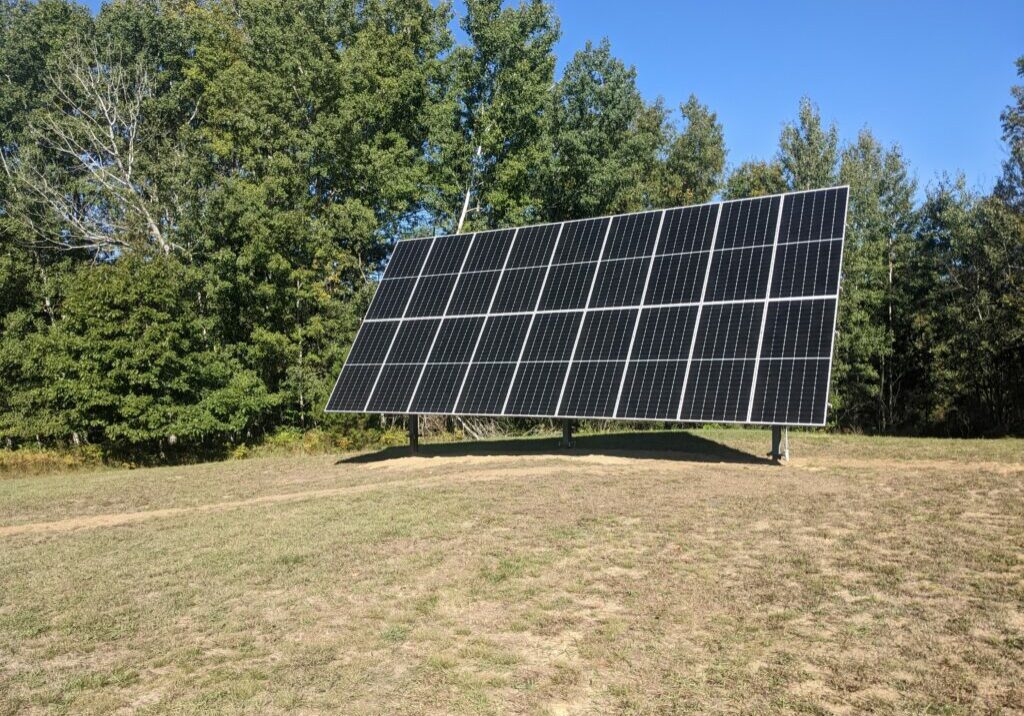| Market | Residential |
| Budget | $6x,xxx |
| Start Date | Sep 14, 2022 |
| Completion Date | Sep 30, 2022 |
| Location | Lake City, MI |

The McKinleys contacted several solar installation companies to see about getting a large installation built on their small farm in Lake City, MI. Pam informed us that she almost went with another company, but our excellently designed systems convinced her that we were the best in the business. The goal for them was to maintain grid connection but have the ability to be totally energy self-sufficient. With the large amount of energy they required to run their farm we decided providing them with 2 arrays of (18) 485 watt bifacial panels each and (5) 5 Kilowatt/ Hour batteries would suffice.
Customer Quote
“I was really blessed by you guys. I was so happy to meet you. And you guys were always just delightful to be around”
“I couldn't give you better than a 10 star rating. I mean, it's just the best”
Analysis
Our team analyzed the McKinleys’ current electrical system and energy usage, laid out on their Consumers Energy bill. This information allows us to customize our energy systems to perfectly suit customer’s needs. Our in-house master electrician carefully designed the electrical diagrams, and we ordered materials from our top tier suppliers accordingly.
Proposal
Pam and Tim’s project required 25.6 kilowatt hours of battery storage and 36 bifacial 485 watt panels installed on two separate ground mounted arrays. With that many solar panels the total amount of power that can be produced is 17.46 kilowatts. A system of this size used to require multiple inverters, however with the fairly recent developments of inverter technology we were able to use Sol Ark’s 15k inverter which was perfect for this job. The inverter is the sort of brain of the whole energy system, inverting DC to AC, charging batteries, monitoring important system data and allowing current from the meter to pass through and feed the customer’s main panel among many other advanced features.
In many of the smaller residential projects we install, the homeowner is usually required to select “critical loads” which will be accessible in a power outage situation. This is due to power limitations from smaller inverters. With the scope of this project being this size however, we were able to back up their entire main panel ensuring that if a power outage occurs their whole home would still be able to function as normal. This is done by shutting off utility power and running conductors from the 200 amp meter into and through an outdoor disconnect switch then into the inverter which in turn feeds the main panel.
While the electrical work is being done our installation team is in the field constructing the arrays. The first step in the construction process is always working with the customer to decide where the ideal location of the array should be. This involves using sun tracking applications that allow us to see the sun's trajectory over the course of the year, providing us with the information necessary to place their arrays in optimal locations. Once the locations are marked we auger the holes, set our posts, and fill them in with concrete. After the concrete sets up we build the upper part of the array, set the panels and wire them together. Our installation team was able to get all of this done, including digging and filling a 200’ trench, in 3 days.
Problem Solving
Every step of the installation process involves its own challenges, but one of the main goals we strive toward is providing an expert level of craftsmanship. Not only do the customers enjoy extra peace of mind seeing the level of care we put into our installations, but our team also takes much pride in providing a high quality finished product.
Scope
The installation we provided for Pam and Tim will drastically reduce their energy bill and will allow them to be a self-sustained energy stronghold for long periods of time without grid power.
Budget
Once we know what the system type and size will need to be we can itemize our required materials to accurately estimate the cost of the project to give to the customer. The budget for a solar energy system of this size to fit Pam and Tim’s needs came out to be $6x,xxx.
Maintenance
Sol Ark inverters include remote monitoring which allows us to keep an eye on data from all of our past installs and make sure they are operating as efficiently as possible, the monitoring technology also allows us to edit inverter settings giving us a high level of customization and control of our installs.
As for personal maintenance of the system, snow removal and (for ground mounts) tilt angle are about the only things the customer has to worry about, we encourage at least 2 tilt adjustments per year to optimize production in the summer and winter months. For snow removal there are a variety of products available to safely help panels shed snow.
Benefits & Impact
On days with full sun they are able to fully charge their batteries and sell over 9000 watts per hour back to the grid. The McKinleys now have a state of the art energy system on site, allowing them to be energy independent and essentially impervious to any tribulations that may strike the utility grid.










